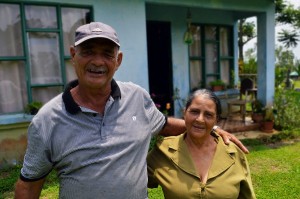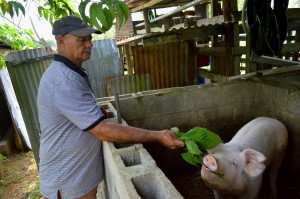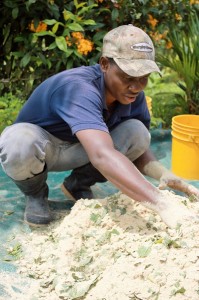25 years working with rural communities

Miguel and his wife María Eugenia pose in front of their house, located in the Las Lomas community of Costa Rica.
Miguel Rojas is 65 years old and lives with his wife on the outskirts of the Las Lomas community; his farm is located near the Cuna de Aves Forest Reserve, about 30 minutes away from EARTH’s campus. Every morning, Miguel gets up at 5 a.m., drinks his coffee and immediately starts his day of caring for others: feeding his chickens, pigs, cows and watering the multitude of plants scattered across the property. For him, working with nature is more than a job, it is a calling. This is the simple country life he chose to live.
He is one of numerous local producers who welcome EARTH students into their lives and allow their farms to serve as living laboratories where students can apply what they are learning in class. “They tell me their ideas and I share mine too, and in this way we’ve created a nice friendship,” explains Miguel. Through his involvement with students and the Community Development Program (CDP), little by little Miguel’s farm has become more integrated and sustainable: he has learned how to create organic fertilizer, installed a larger and more efficient biodigester, started a free-range chicken project, built a tilapia pond and constructed a greenhouse that supplies his family with fresh vegetables.

Miguel Rojas uses the natural resources on his farm sustainability, including the versatile nacedero plant that is made into food for pigs, chickens and tilapia.
He explains, “Nothing goes to waste here, we get our water from a tank and whatever is left goes into the tilapia pond. The manure from the chickens, pigs and cows goes into the biodigester, which produces cooking gas and decontaminates the water, which also goes into the pond. The fish, chickens and pigs eat ‘nacedero,’ a plant that I have growing all over the farm.” With this integrated production system, farmers can save a substantial amount of money and live off of what they produce, whether by consuming their own goods or selling them to increase their economic income. For example, Miguel used to buy one sack of chicken feed for approximately $32 but now, after learning how to make it himself, pays around $10 for the same amount.
According to Miguel, working in the agriculture business requires a “love of animals and plants” and he credits EARTH students and the CDP for teaching him to protect resources, reforest his farm and produce sustainably. “With the trainings we receive from EARTH, you learn to work in an organized way, with lower costs and higher production- we don’t even buy fertilizer anymore. Here, you don’t need a lot of money to get by because we have almost everything.”
When thinking about the future, Miguel hopes that his children will keep working on the farm instead of selling it. For him, it is important that young people return to the country. “Reconsider and go back to the land, produce for yourselves and for your children because life is only going to get tougher,” he reflects. “I hope that God lets me live longer (even though I’m an old man) so that I can walk around and keep planting, because that is life.”
Make a gift today and contribute to rural development in communities around the world.





